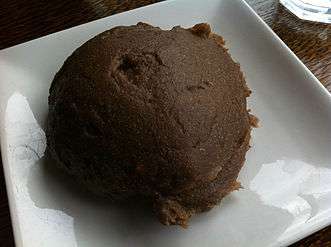Amala (food)

Àmàlà is a Nigerian food made out of yam flour and/or cassava flour.[1] Yam flour is yam that has been peeled, sliced, cleaned, dried and then blended into a flour, also called elubo. Yam is white in colour but it turns into a brownish colour after it has been dried; this gives àmàlà its thick brown colour.[2][3] Àmàlà is derived from Western Africa and is eaten mostly by the Yoruba people in Nigeria.[4] It could be served with a variety of ọbẹ (soup), such as ẹfọ, ilá, ewédú, ogbono or gbegiri (black-eyed beans soup).
Types
There are two types of àmàlà: àmàlà isu and amala lafun.
Yam flour (àmàlà isu)
This is the most common type of àmàlà. The flour used is derived from yam. Yam, a common name for species in the genus Dioscorea, is grown in Africa, Asia, Caribbean, Oceania and Latin America. 95% of yam is cultivated and harvested in West Africa. Yam can be barbecued, roasted, fried, grilled boiled, smoked and grated. Àmàlà isu is made with yam flour that has been dried; this gives it a black/brownish colour when added to boiling hot water. Amala is high in carbohydrates and packs a lot of calories.
Cassava flour (àmàlà láfún)
The second type is àmàlà láfún, which is derived from cassava flour. Cassava is a woody shrub of the Euphorbiaceae (spurge) family. Cassava, along with yam, is the most important source of food carbohydrate in Nigeria; making Nigeria the world’s largest producer of cassava. Cassava flour when dried and powdery can be used to make àmàlà láfún. When it is fermented and flaky it is called garri (another common Nigerian cuisine). Àmàlà láfún is made with cassava flour that has been dried; this gives it a light brown colour when added to hot water.It is eaten mostly by the Egba people in Nigeria.
Plantain flour (Amala ogede)
Another type of Amala is amala/elubo ogede. The low carbohydrate level in the plantain flour makes a good food for diabetic patients and other illnesses that require less of carbohydrate food. It is also light hence it quickly digest. As a result of being easy to digest, it helps weight lose. Unripe plantain is pealed dried and grated into flour and turned in boiled water to become amala ogede. it is light brownish in colour when prepared.
Preparation
The only ingredient needed when making àmàlà is boiling water and either one of the two types of flour. Once the water has come to a boil, the heat is reduced. The flour is added and stirred until all the water is absorbed. More hot water is added, then the dough is left to simmer for approximately five minutes.[5] Then the dough is pulled along with the water until desired texture. The pulling of the dough into a smooth paste is the most difficult part of making àmàlà.
Dishes
Amala can be eaten with various types of soups, they are:
- Egusi soup: this is made out of thickened melon seeds and leaf vegetable
- Ewedu soup: this is made from cooked and grated Corchorus leaves with/without small quantity of egusi and/or locust beans.
- Okro soup: this is made from okra
- Efo riro: this is made from vegetables and a mixture of meat, fish, etc.[6]
- Ogbono soup: this is made from ground ogbono seeds and a mixture of Stock fish, locust beans is added for garnishing.
- Gbegiri soup: this is made from dried beans
See also
References
- ↑ Ferris, R. S. B; Uwaegbute A. C.; Osho S. M.; Obatolu V. A. (1995). "Acceptability and chemical evaluation of fortified yam (Discorea spp.) products.". Postharvest technology and commodity marketing: proceedings of a postharvest conference 2 Nov. to 1 Dec. 1995. Acra, Ghana: 172. ISBN 978-978-131-111-6.
- ↑ Balogh, Esther (1989). "History and perspectives of stable foods in Africa". Oxford Symposium on Food & Cookery. p. 51.
- ↑ Dumont, Roland (2006). Biodiversity and Domestication of Yams in West Africa: Traditional Practices Leading to Dioscorea Rotundata Poir. Editions Quae. p. 28.
- ↑ Roots, Tubers, Plantains and Bananas in Human Nutrition. Rome: Food and Agriculture Organization of the United Nations. 1990. p. 68.
- ↑ Badiru, I, & Badiru, D. (2013). Isi Cookbook: Collection of Easy Nigerian Recipes. Bloomington: iUniverse. p. 23.
- ↑ Rees, D., Farell, G., & Orchard, J. (2012). Crop Post-Harvest: Science and Technology, Perishables. Hoboken: John Wiley & Sons. p. 408.